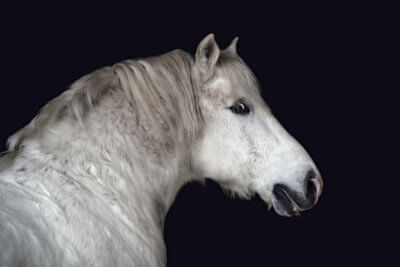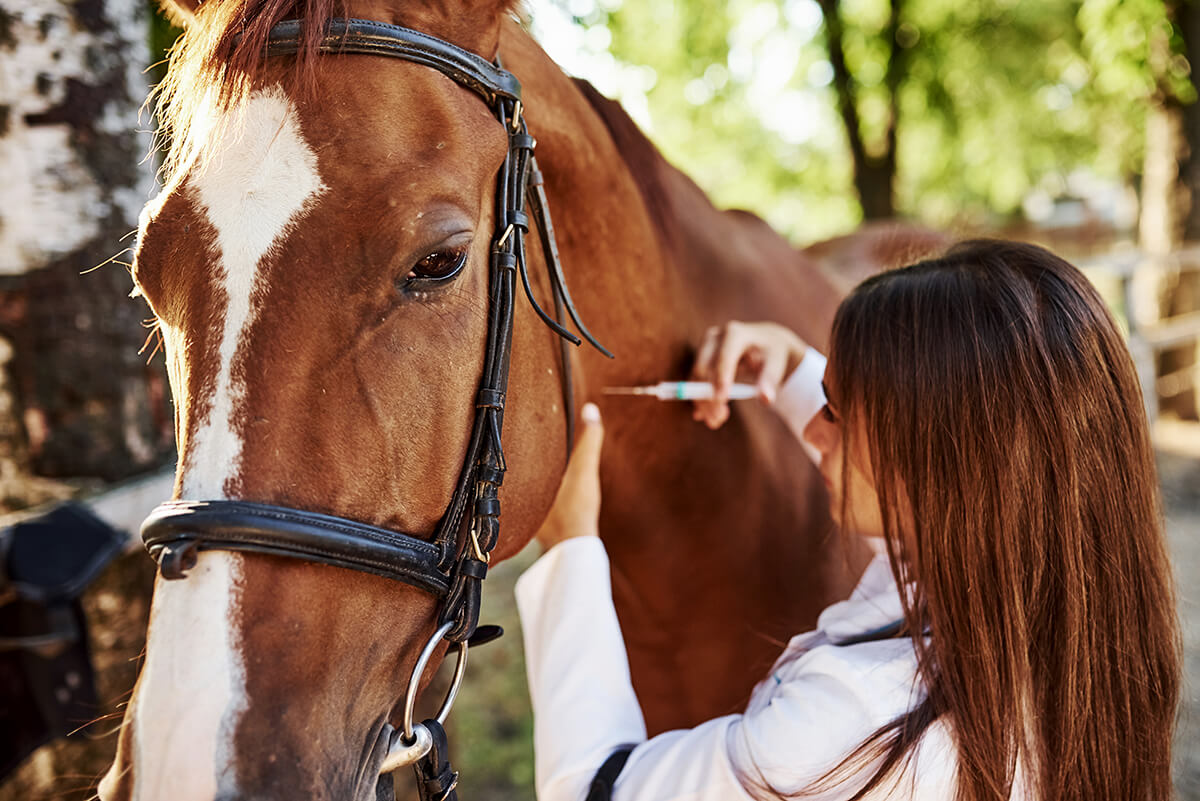Long summer days turn into crisp fall days and before we know it, winter has arrived. When we think of old man winter in horse form, we think of an old horse who has a long, shaggy hair coat and a swayed back, fat deposits in odd places, and is an easy keeper. As a child, I was taught these were signs of a well-loved older horse, but something deeper is going on. These clinical symptoms could be signs of equine Cushing’s Syndrome, also known as PPID (Pars Pituitary Intermedia Dysfunction).
Equine Cushing’s disease occurs when the portion of the brain that regulates hormones—the pituitary gland—has become enlarged and therefore the hormone cascade becomes altered. Dopamine, a hormone that regulates other hormones, is often inhibited or is not accurately recognized by the body. Without dopamine regulation, a hormone called ACTH (adrenocorticotropic hormone) is produced in excess. Excess ACTH results in the body’s natural stress hormone, cortisol, to become activated at elevated levels due to the excessive amounts of ACTH. Excessive stress hormone (cortisol) suppresses the immune system and predisposes these older horses to infections.
The classic picture of a horse suffering from Cushing’s includes a long, curly hair coat (hirsutism), fat deposits in odd places, a cresty neck, potbellied appearance, and delayed shedding. Subtle signs can include suffering from repeat hoof abscesses, skin infections, eye ulcers, laminitis, slow healing wounds, and decaying teeth. These subtle signs occur due to suppression of the immune system.
Exercise intolerance, excessive urination, excessive drinking, weight loss, infertility, mental impairment, and excessive sweating can all be additional signs of the disease. Traditionally, older horses suffer from Cushing’s but horses as young as ten years old have been diagnosed.
 Diagnosis is made based upon on clinical symptoms and bloodwork. Often blood is pulled to check the horse for elevated ACTH levels. This is considered a screening test, meaning a horse who has elevated levels of ACTH has the disease, but a horse who has normal levels of ACTH may still have Cushing’s. Additional tests including the TRH (thyrotropin releasing hormone) stimulation test or dexamethasone suppression test are often performed for a final diagnosis.
Diagnosis is made based upon on clinical symptoms and bloodwork. Often blood is pulled to check the horse for elevated ACTH levels. This is considered a screening test, meaning a horse who has elevated levels of ACTH has the disease, but a horse who has normal levels of ACTH may still have Cushing’s. Additional tests including the TRH (thyrotropin releasing hormone) stimulation test or dexamethasone suppression test are often performed for a final diagnosis.
Research has demonstrated a close link between equine metabolic syndrome and Cushing’s. Both conditions are linked to insulin resistance and laminitis. A horse that is overweight can be predisposed to insulin resistance leading to laminitis (founder). Horses that are being tested for Cushing’s should have their insulin and glucose levels tested as well. Horses that suffer from Cushing’s and equine metabolic syndrome need to be managed with medication, diet, and exercise.
Unfortunately, there is no cure for equine Cushing’s, but a daily tablet called Pergolide can be administered for treatment. Pergolide is a dopamine agonist helping regulate the excessive levels of ACTH. Studies have demonstrated that the administration of compounded Pergolide is not as effective in managing the disease as administering labeled Pergolide. Additional treatments include cyproheptadine.
Equine Cushing’s cannot be prevented but precautions can be taken to lower the severity of the disease. These precautions include weight management, continued exercise of older horses, and testing for the disease at the first appearance of subtle signs. Weight management cannot be emphasized enough; feeding your horse only what he needs, placing a grazing muzzle during peak growing seasons, and limiting the number of sugary treats such as carrots and apples is so important. Let’s help our old horses live well!
See this article in the 2020 December online edition:

Dr. Sara Perkins, DVM, graduated from the veterinary school at Washington State University in 2000 and completed an internship at Rood and Riddle in Lexington, Kentucky in 2001. After working with the equine internal medicine department at UC Davis in 2002 she went into private practice, opening Equine Medical Services of Rainier, WA in 2005. Sara partnered with EquinaVet in Germany in 2017 in order to make their nutritional supplements available to horses in the USA. Currently, Sara divides her time between veterinary practice, working for EquinaVet USA, riding dressage and cutting horses, and managing Waystation Farm where she breeds Lusitano horses. Visit www.equinemedservices.com to learn more.

